Alfa Romeo Giulietta 2016 Owner's Manual
Manufacturer: ALFA ROMEO, Model Year: 2016, Model line: Giulietta, Model: Alfa Romeo Giulietta 2016Pages: 288, PDF Size: 7.34 MB
Page 221 of 288
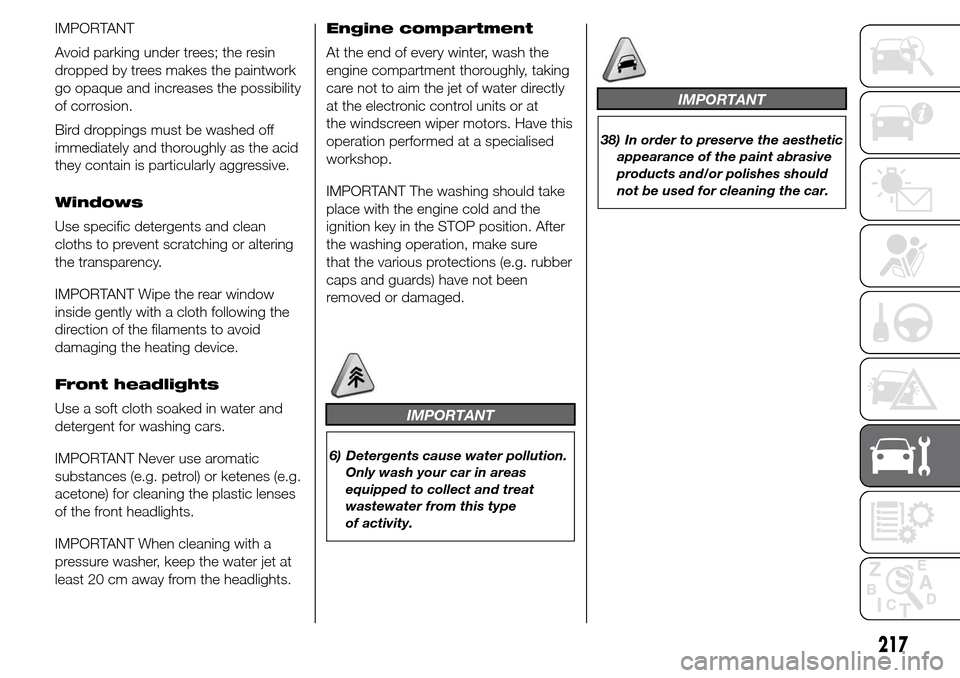
IMPORTANT
Avoid parking under trees; the resin
dropped by trees makes the paintwork
go opaque and increases the possibility
of corrosion.
Bird droppings must be washed off
immediately and thoroughly as the acid
they contain is particularly aggressive.
Windows
Use specific detergents and clean
cloths to prevent scratching or altering
the transparency.
IMPORTANT Wipe the rear window
inside gently with a cloth following the
direction of the filaments to avoid
damaging the heating device.
Front headlights
Use a soft cloth soaked in water and
detergent for washing cars.
IMPORTANT Never use aromatic
substances (e.g. petrol) or ketenes (e.g.
acetone) for cleaning the plastic lenses
of the front headlights.
IMPORTANT When cleaning with a
pressure washer, keep the water jet at
least 20 cm away from the headlights.Engine compartment
At the end of every winter, wash the
engine compartment thoroughly, taking
care not to aim the jet of water directly
at the electronic control units or at
the windscreen wiper motors. Have this
operation performed at a specialised
workshop.
IMPORTANT The washing should take
place with the engine cold and the
ignition key in the STOP position. After
the washing operation, make sure
that the various protections (e.g. rubber
caps and guards) have not been
removed or damaged.
IMPORTANT
6) Detergents cause water pollution.
Only wash your car in areas
equipped to collect and treat
wastewater from this type
of activity.
IMPORTANT
38) In order to preserve the aesthetic
appearance of the paint abrasive
products and/or polishes should
not be used for cleaning the car.
217
Page 222 of 288
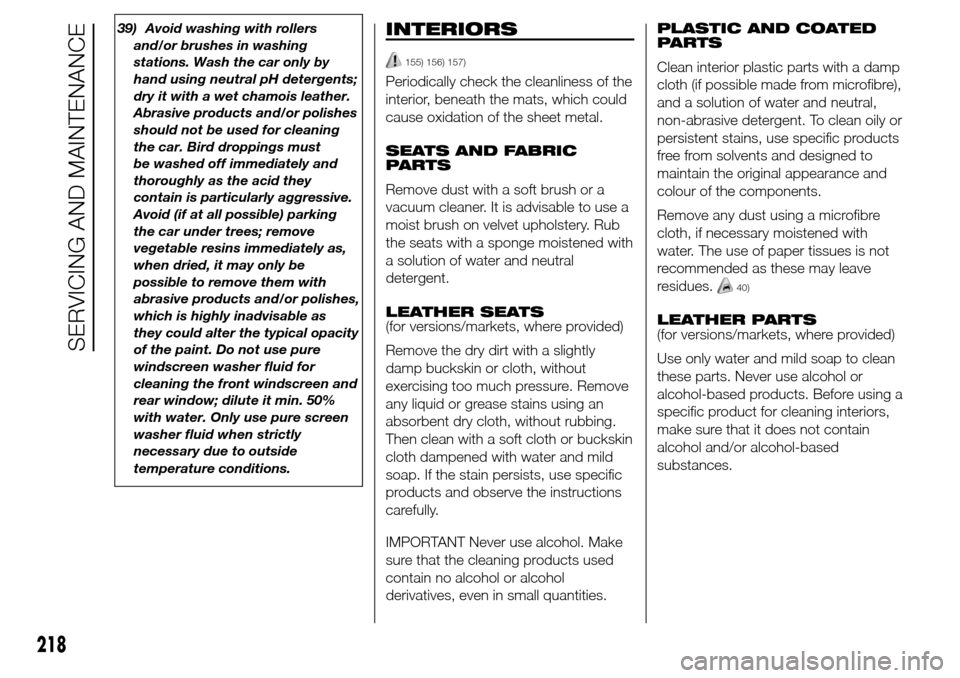
39) Avoid washing with rollers
and/or brushes in washing
stations. Wash the car only by
hand using neutral pH detergents;
dry it with a wet chamois leather.
Abrasive products and/or polishes
should not be used for cleaning
the car. Bird droppings must
be washed off immediately and
thoroughly as the acid they
contain is particularly aggressive.
Avoid (if at all possible) parking
the car under trees; remove
vegetable resins immediately as,
when dried, it may only be
possible to remove them with
abrasive products and/or polishes,
which is highly inadvisable as
they could alter the typical opacity
of the paint. Do not use pure
windscreen washer fluid for
cleaning the front windscreen and
rear window; dilute it min. 50%
with water. Only use pure screen
washer fluid when strictly
necessary due to outside
temperature conditions.INTERIORS
155) 156) 157)
Periodically check the cleanliness of the
interior, beneath the mats, which could
cause oxidation of the sheet metal.
SEATS AND FABRIC
PARTS
Remove dust with a soft brush or a
vacuum cleaner. It is advisable to use a
moist brush on velvet upholstery. Rub
the seats with a sponge moistened with
a solution of water and neutral
detergent.
LEATHER SEATS
(for versions/markets, where provided)
Remove the dry dirt with a slightly
damp buckskin or cloth, without
exercising too much pressure. Remove
any liquid or grease stains using an
absorbent dry cloth, without rubbing.
Then clean with a soft cloth or buckskin
cloth dampened with water and mild
soap. If the stain persists, use specific
products and observe the instructions
carefully.
IMPORTANT Never use alcohol. Make
sure that the cleaning products used
contain no alcohol or alcohol
derivatives, even in small quantities.PLASTIC AND COATED
PARTS
Clean interior plastic parts with a damp
cloth (if possible made from microfibre),
and a solution of water and neutral,
non-abrasive detergent. To clean oily or
persistent stains, use specific products
free from solvents and designed to
maintain the original appearance and
colour of the components.
Remove any dust using a microfibre
cloth, if necessary moistened with
water. The use of paper tissues is not
recommended as these may leave
residues.
40)
LEATHER PARTS
(for versions/markets, where provided)
Use only water and mild soap to clean
these parts. Never use alcohol or
alcohol-based products. Before using a
specific product for cleaning interiors,
make sure that it does not contain
alcohol and/or alcohol-based
substances.
218
SERVICING AND MAINTENANCE
Page 223 of 288
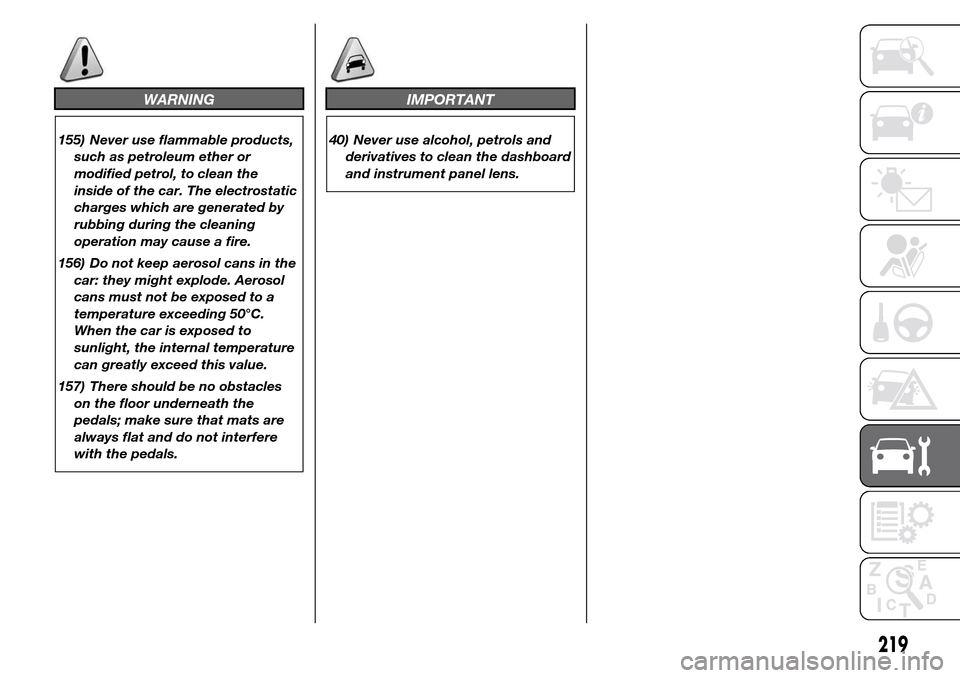
WARNING
155) Never use flammable products,
such as petroleum ether or
modified petrol, to clean the
inside of the car. The electrostatic
charges which are generated by
rubbing during the cleaning
operation may cause a fire.
156) Do not keep aerosol cans in the
car: they might explode. Aerosol
cans must not be exposed to a
temperature exceeding 50°C.
When the car is exposed to
sunlight, the internal temperature
can greatly exceed this value.
157) There should be no obstacles
on the floor underneath the
pedals; make sure that mats are
always flat and do not interfere
with the pedals.
IMPORTANT
40) Never use alcohol, petrols and
derivatives to clean the dashboard
and instrument panel lens.
219
Page 224 of 288
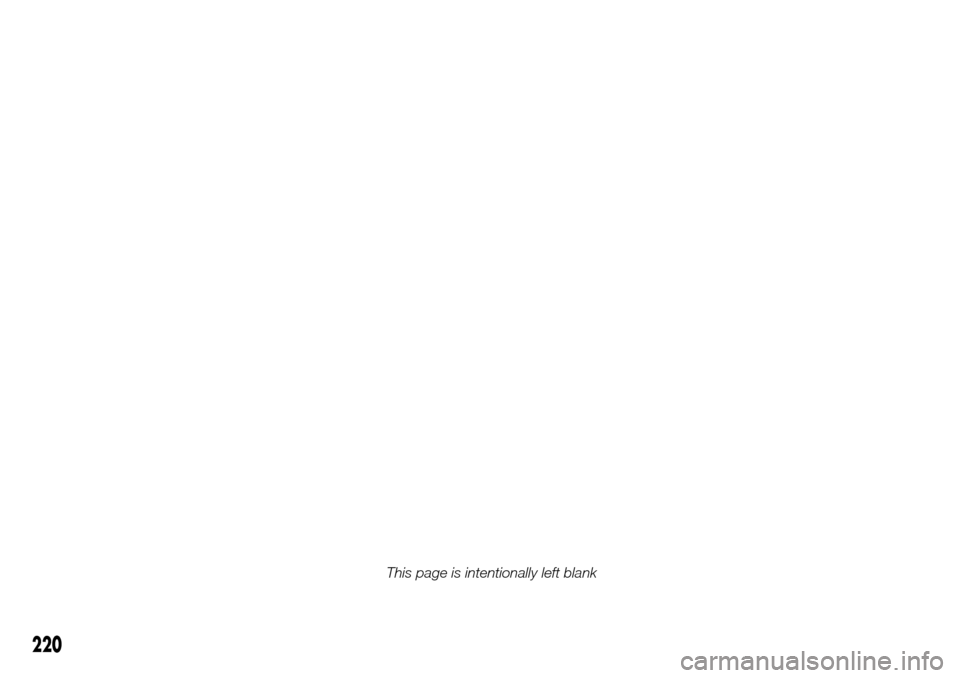
220
This page is intentionally left blank
Page 225 of 288
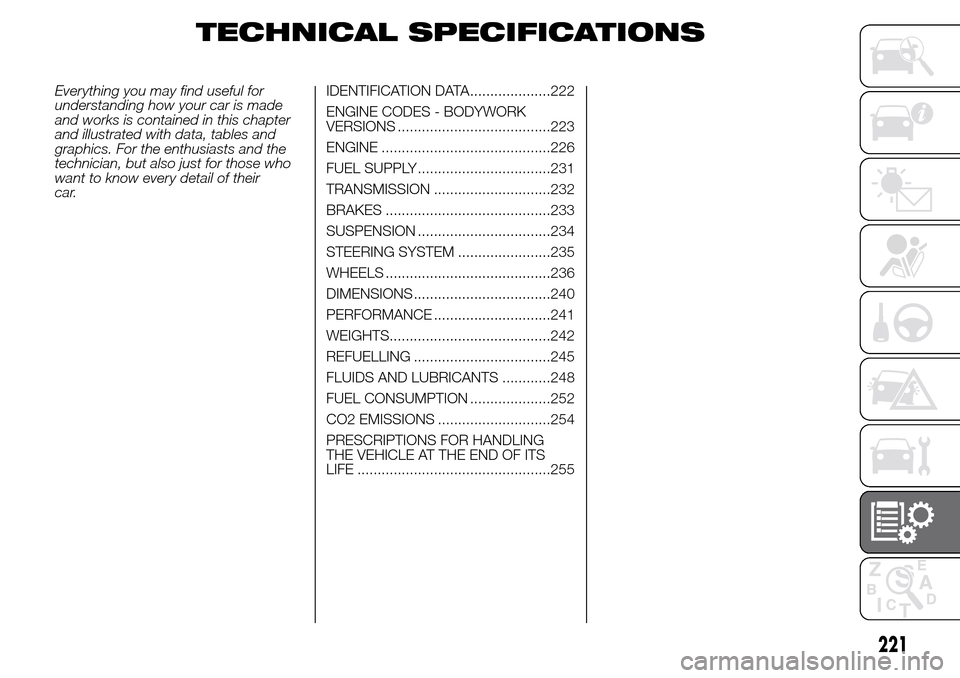
TECHNICAL SPECIFICATIONS
Everything you may find useful for
understanding how your car is made
and works is contained in this chapter
and illustrated with data, tables and
graphics. For the enthusiasts and the
technician, but also just for those who
want to know every detail of their
car.IDENTIFICATION DATA....................222
ENGINE CODES - BODYWORK
VERSIONS ......................................223
ENGINE ..........................................226
FUEL SUPPLY .................................231
TRANSMISSION .............................232
BRAKES .........................................233
SUSPENSION .................................234
STEERING SYSTEM .......................235
WHEELS .........................................236
DIMENSIONS ..................................240
PERFORMANCE .............................241
WEIGHTS........................................242
REFUELLING ..................................245
FLUIDS AND LUBRICANTS ............248
FUEL CONSUMPTION ....................252
CO2 EMISSIONS ............................254
PRESCRIPTIONS FOR HANDLING
THE VEHICLE AT THE END OF ITS
LIFE ................................................255
221
Page 226 of 288
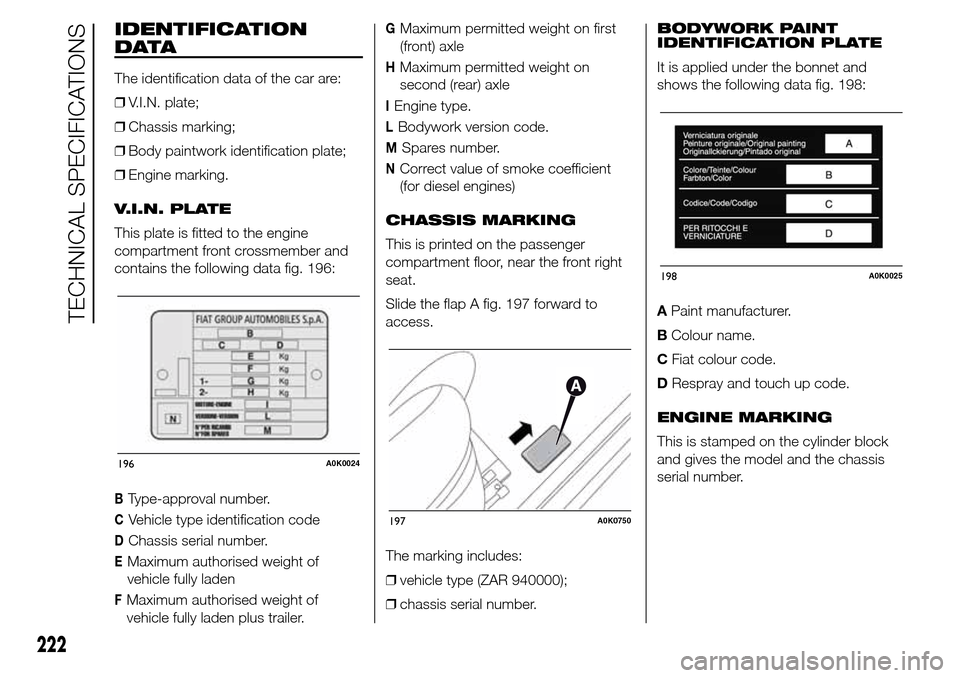
IDENTIFICATION
DATA
The identification data of the car are:
❒V.I.N. plate;
❒Chassis marking;
❒Body paintwork identification plate;
❒Engine marking.
V.I.N. PLATE
This plate is fitted to the engine
compartment front crossmember and
contains the following data fig. 196:
BType-approval number.
CVehicle type identification code
DChassis serial number.
EMaximum authorised weight of
vehicle fully laden
FMaximum authorised weight of
vehicle fully laden plus trailer.
GMaximum permitted weight on first
(front) axle
HMaximum permitted weight on
second (rear) axle
IEngine type.
LBodywork version code.
MSpares number.
NCorrect value of smoke coefficient
(for diesel engines)
CHASSIS MARKING
This is printed on the passenger
compartment floor, near the front right
seat.
Slide the flap A fig. 197 forward to
access.
The marking includes:
❒vehicle type (ZAR 940000);
❒chassis serial number.BODYWORK PAINT
IDENTIFICATION PLATE
It is applied under the bonnet and
shows the following data fig. 198:
APaint manufacturer.
BColour name.
CFiat colour code.
DRespray and touch up code.
ENGINE MARKING
This is stamped on the cylinder block
and gives the model and the chassis
serial number.
196A0K0024
197A0K0750
198A0K0025
222
TECHNICAL SPECIFICATIONS
Page 227 of 288
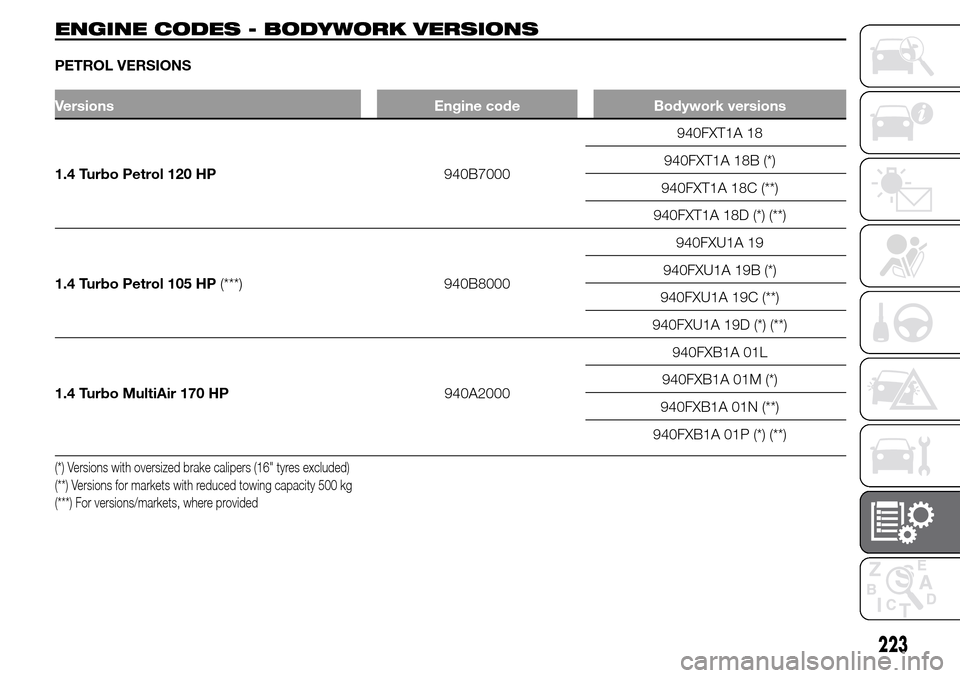
ENGINE CODES - BODYWORK VERSIONS
PETROL VERSIONS
Versions Engine code Bodywork versions
1.4 Turbo Petrol 120 HP940B7000940FXT1A 18
940FXT1A 18B (*)
940FXT1A 18C (**)
940FXT1A 18D (*) (**)
1.4 Turbo Petrol 105 HP(***) 940B8000940FXU1A 19
940FXU1A 19B (*)
940FXU1A 19C (**)
940FXU1A 19D (*) (**)
1.4 Turbo MultiAir 170 HP940A2000940FXB1A 01L
940FXB1A 01M (*)
940FXB1A 01N (**)
940FXB1A 01P (*) (**)
(*) Versions with oversized brake calipers (16" tyres excluded)
(**) Versions for markets with reduced towing capacity 500 kg
(***) For versions/markets, where provided
223
Page 228 of 288

Versions Engine code Bodywork versions
1.4 Turbo MultiAir 170 HP TCT940A2000940FXB11 10G (****)
940FXB11 10H (*****)
940FXB11 10L (******)
940FXB11 10M (*******)
1.4 Turbo MultiAir 170 HP TCT(***) 940A2000940FXB11 10N
940FXB11 10P (*)
1.4 Turbo MultiAir 163 HP(***) 955A8000940FXG1A 06E
940FXG1A 06F (*)
1.4 Turbo MultiAir 163 HP TCT(***) 955A8000940FXG11 13C
940FXG11 13D (*)
1750 Turbo Petrol 235 HP(***) 940A1000 940FXC1A 02
(****) Towable load 1300 kg
(*****) Trim levels with oversized brake calipers (towable load 1300 kg)
(******) Towable load 0 kg (for specific countries)
(*******) Trim levels with oversized brake calipers (towable load 0 kg for specific countries) (***) For versions/markets, where provided (*) Versions with oversized brake calipers (16" tyres excluded)
224
TECHNICAL SPECIFICATIONS
Page 229 of 288
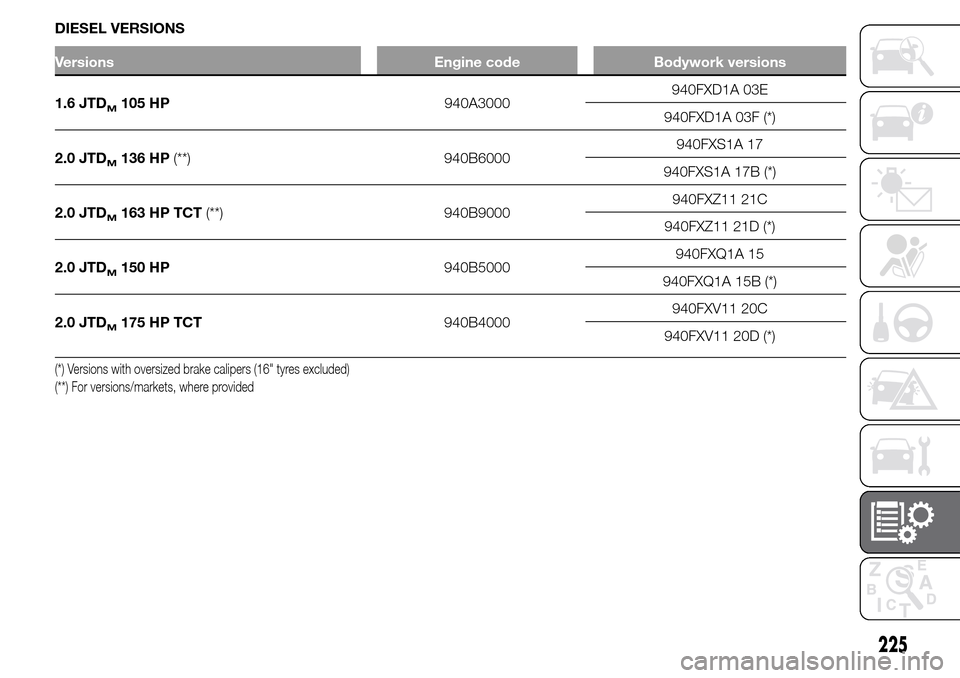
DIESEL VERSIONS
Versions Engine code Bodywork versions
1.6 JTDM105 HP940A3000940FXD1A 03E
940FXD1A 03F (*)
2.0 JTD
M136 HP(**) 940B6000940FXS1A 17
940FXS1A 17B (*)
2.0 JTD
M163 HP TCT(**) 940B9000940FXZ11 21C
940FXZ11 21D (*)
2.0 JTD
M150 HP940B5000940FXQ1A 15
940FXQ1A 15B (*)
2.0 JTD
M175 HP TCT940B4000940FXV11 20C
940FXV11 20D (*)
(*) Versions with oversized brake calipers (16" tyres excluded)
(**) For versions/markets, where provided
225
Page 230 of 288
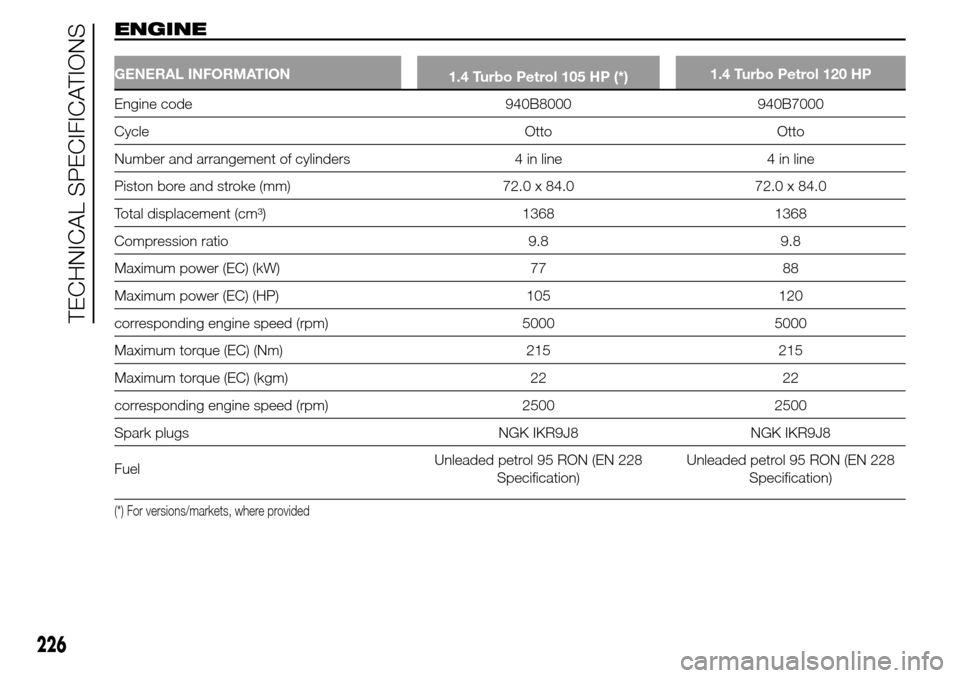
ENGINE
GENERAL INFORMATION
1.4 Turbo Petrol 105 HP (*)1.4 Turbo Petrol 120 HP
Engine code 940B8000 940B7000
Cycle Otto Otto
Number and arrangement of cylinders 4 in line 4 in line
Piston bore and stroke (mm) 72.0 x 84.0 72.0 x 84.0
Total displacement (cm³) 1368 1368
Compression ratio 9.8 9.8
Maximum power (EC) (kW) 77 88
Maximum power (EC) (HP) 105 120
corresponding engine speed (rpm) 5000 5000
Maximum torque (EC) (Nm) 215 215
Maximum torque (EC) (kgm) 22 22
corresponding engine speed (rpm) 2500 2500
Spark plugs NGK IKR9J8 NGK IKR9J8
FuelUnleaded petrol 95 RON (EN 228
Specification)Unleaded petrol 95 RON (EN 228
Specification)
(*) For versions/markets, where provided
226
TECHNICAL SPECIFICATIONS